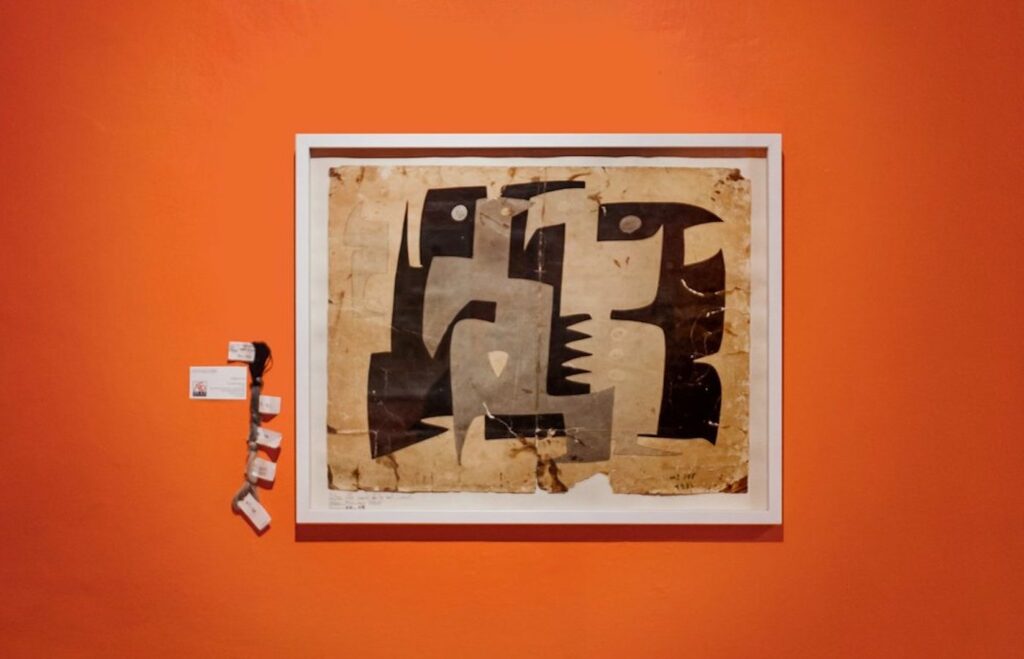OH Gallery, Dakar, Senegal
09 Mar 2023 - 29 Apr 2023

Les esprits de la nuit, 1975, acrylique sur papier, 50 x 65 cm. Carton original appartement aux Manufactures Sénégalaises des Arts Décoratifs de Thiès. Courtesy of OH Gallery
Diouf was born in 1949, in Djigod, Senegal, where his story began like many of the Senegalese artists of his generation. The OH Gallery exhibition is the happy pretext of a long stay of the artist in Dakar, a return to the country under the sign of creation, and the opportunity to present to the public the history of a journey begun in Senegal fifty years ago.
Little by little, Diouf invents a vibrant world of poetry in which Senegalese flora, spirits, pangols and formal inspirations of the Black world intertwine and merge. His forms synthesise animals, organic or mineral materials, African sculptures: it is the branch, the stone, the bird, the mask, all at the same time. It is also the time of his first collections. In 1984, Diouf said in an interview for German television that he learned to love abstract forms by collecting dead wood in the forest, which he kept. Even today, even before crossing the threshold of his Zurich studio, visitors are greeted by strange piles of objects. In a glass case on the landing, paper coffee filters that he has left to dry, on top of carobs, pieces of bark, pebbles. Inside, everywhere, on the solid floor, on every piece of furniture, on the sills of the high windows, small and big stones, driftwood, everyday objects, mingle with the artist’s works and form a deceptively disordered decor. As you approach, you notice that the shells are arranged from the smallest to the largest, that the African knife in its sheath of leather and cowrie shells also has its place. Diouf extracts their forms from these naturalia to make quasi-abstractions. By reinventing the theme of fauna and flora from a formal vocabulary resolutely turned towards modernism, Diouf thwarts the trap of the assignment to nature, of the representation of an African Eden necessarily primitivization for the critics of the time.
Indeed, in these first decades of Senegalese independence, the need to theorise his practice imposed itself on Diouf. It was necessary to think of this painting. It was then a question of decentering, on all levels, a world and an international artistic scene organised by the West, around the West. His reflections are thus inscribed from the beginning in the heart of the burning debates on the manufacture of a contemporary art authentically African which, for some, had all the makings of a chimera. Researchers, but also some of the artists in Senegal, often pointed out the primitivist character of Lods’ discourse and his teaching, the now famous pedagogy of laissez-faire. Lods believed that it was necessary to preserve the artists of Africa from all instructions and external influences, which he judged likely to corrupt their Africanness. Iba Ndiaye in particular had denounced the dangers of defining an essentialist, even racialist, Africanity that restricts and imprisons, like a cultural ghetto in which African artists would lock themselves for fear of corrupting their originality (Ndiaye 1995).
On the contrary, Diouf and some of his comrades saw in the definition of an African culture a struggle for self-determination. They sought first, as Senghor encouraged them, what were the values and references of this culture. Adhering to some of the narratives but aware of the danger of this ridge line, Diouf elaborates a work, whose formal and thematic path preserves him from these pitfalls. From the outset, he rejects anecdotal subjects. I do not paint the woman who piles up the millet, or who fetches the calabash, I do not share that, I am looking for a much deeper dimension, linked to nature, which is that of the man who thinks, who is connected to everything.
He also seems sensitive to the Senghorian conceptualization of asymmetrical parallelism, and takes up this taste for the presumed asymmetry of African forms. His characters and motifs seem to be variations on the famous throwing knives of Central Africa, which he says he observed a lot in books and in the many ethnographic museums he visited during his life. The African forms that came out, the cosmogony of the Black world was always there, because the discourse was also there, because we were looking for our way, for modern Africa, for Africa that wants to bring something to the world.
Diouf quickly became one of the most recognised artists on the national scene. First of all, the president had a large tapestry woven in France for his music room. Théodore Diouf participates in the first two national shows, organised at the Musée Dynamique whichprepare the great exhibition Art sénégalais d’aujourd’hui. The event opened at the Grand Palais in Paris in the spring of 1974 and then travelled the world for a decade. One of his works was chosen for the poster campaign of the Paris metro. Six were selected to be woven at the Manufactures de Thiès. He became, according to Senghor’s wish, one of the artistic ambassadors of post-colonial Senegal and of its artistic school, the School of Dakar, a label with shifting contours that has been constantly breached, consolidated,questioned, and whose definitions have evolved according to the scene, the reception, and sometimes exhibitions.